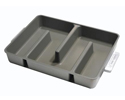OI From a Doctor's Point of View
Posted on October 01, 2006 at 03:01 AM
 Omaha is lucky to have two world class medical facilities at it's disposal. And it may be suprising to some, but it is home to some of the best doctors and state-of-the-art equipment when it comes to OI. I contacted Dr. Horacio Plotkin, who is Assistant Professor of Pediatrics and Orthopedic Surgery at the University of Nebraska Medical Center and Medical Director for Metabolic Bone Diseases Clinic at Children’s Hospital, and asked him to tell the story of how he became involed with OI. Here are his words:
Omaha is lucky to have two world class medical facilities at it's disposal. And it may be suprising to some, but it is home to some of the best doctors and state-of-the-art equipment when it comes to OI. I contacted Dr. Horacio Plotkin, who is Assistant Professor of Pediatrics and Orthopedic Surgery at the University of Nebraska Medical Center and Medical Director for Metabolic Bone Diseases Clinic at Children’s Hospital, and asked him to tell the story of how he became involed with OI. Here are his words:
My relationship with OI started almost 20 years ago, when I was rotating by neonatology as part of my pediatric residency. A child with extremely severe OI was born, and there was nothing we could do to help him. He passed away a few hours later. I’ve realized then that I had a dream, and that was to help children with OI. That lead me to avidly read any article I could about pediatric bone diseases. Including rickets that unfortunately is very common in South America.
When residency was over, a fellowship in Pediatric Endocrinology at the National Pediatric Hospital of Buenos Aires followed. There, Dr. Hernan Mendilaharzu, an "old-fashioned" doctor with an incredible clinical experience, guided my first steps in the amazing field of hormones and receptors.
In 1993, the Metabolic Research Institute of Buenos Aires was searching for a pediatric endocrinologist, to conduct a research program. The aim was to find normal values for bone density in young population. I got the job, and the result was a three year fellowship, during which I have published seven papers, and made 30 presentations at scientific meetings.
I also became a member of the Pediatric Working Group Committee of the American Society of Bone and Mineral Research (which I chaired in 2000). The fellowship included a three-month rotation in the Shriners Hospital in Canada. While in Canada, I was invited by Dr. Andrew Stewart to coordinate a clinical research project at Yale University School of Medicine, in Connecticut. The subject was Use of Parathyroid Hormone Related Protein (PTHrP) for the Treatment of Postmenopausal Osteoporosis. A little far away from the children that I was used to work with, but still a great experience, working with one of the foremost authorities in the field of Endocrinology.
As a part of our work together, we wrote a chapter for a book about Clinical Endocrinology, and published the results of our research. In August, 1997 I arrived in Montreal on a warm sunny day. It was not a reflection of the crude winter that would come later. But the warm people of Montreal made it nice to be there, even in the middle of the worst snow storm. My main project at the Shriners was related to the treatment of children affected with severe osteogenesis imperfecta using a new bisphosphonate, alendronate. The study included 15 Shriners Hospitals in USA and Canada.
I have also been involved in the treatment of infants and children with pamidronate, another bisphosphonate, and in the follow-up of children with different metabolic diseases of the bones. In June 2002, I started in a new position at the University of Nebraska Medical Center and the Children's Hospital of Omaha, Nebraska. These institutions, with state-of-the-art technology and incredible personnel, are amongst the best in the world. We have started the OI and metabolic bone diseases clinics.
The multi-disciplinary approach is the basis for the clinics, including OT, PT, orthopedic surgery, social worker, audiology, nutritionist, psychologist, amongst others. I am now Assistant Professor of the University Of Nebraska School of Medicine and Director of the Metabolic Bone Diseases clinic at Children's Hospital. We have children coming from 27 states in the USA, and places as far as Mexico, Spain and Romania to seek treatment and evaluation with us.
I have written 6 chapters in books and published 46 articles related to my field of study. We have developed a low-dose protocol for the use of pamidronate, with very promising results. I have also published a new classification of OI and related disorders, as I feel that the classic classification in 4 types underscores the complexity of this condition.
After many years reading about osteogenesis imperfecta (and the lack of an effective treatment for it), I am very proud to be part of this amazing adventure of helping children, relieving their pain, increasing their independency and physical activity, and drawing smiles on their families. They came to Omaha and find a friendly team, working together, with the simple aim of making those children a little bit happier, every day.
Thank you Dr. Plotkin. It is truly amazing that we have such talented professioanls right here in our community. If you would like to read more about Dr. Plotkin and the work he does, check out his website www.geocities.com/dr_plotkin/.
Permalink | Comments (0) | post to del.icio.us | submit to Digg



